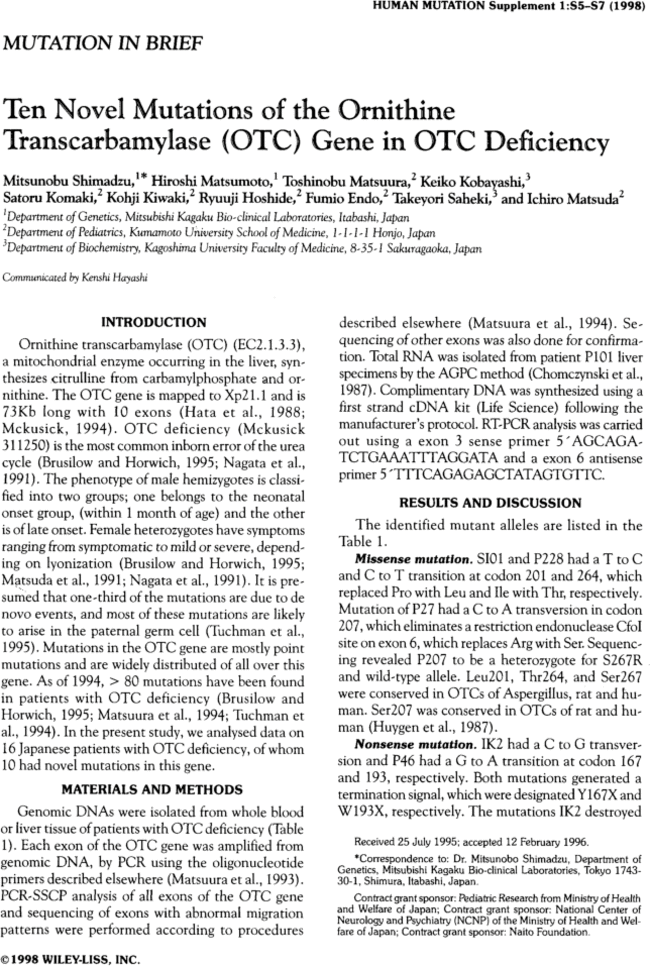Ten novel mutations of the ornithine transcarbamylase (OTC) gene in OTC deficiency
Corresponding Author
Dr. Mitsunobu Shimadzu
Department of Genetics, Mitsubishi Kagaku Bio-clinical Laboratories, Itabashi, Japan
Department of Genetics, Mitsubishi Kagaku Bio-clinical Laboratories, Tokyo 1743-30-1, Shimura, Itabashi, JapanSearch for more papers by this authorHiroshi Matsumoto
Department of Genetics, Mitsubishi Kagaku Bio-clinical Laboratories, Itabashi, Japan
Search for more papers by this authorToshinobu Matsuura
Department of Pediatrics, Kumamoto University School of Medicine, 1-1-1-1 Honjo, Japan
Search for more papers by this authorKeiko Kobayashi
Department of Biochemistry, Kagoshima University Faculty of Medicine, 8-35-1 Sakuragaoka, Japan
Search for more papers by this authorSatoru Komaki
Department of Pediatrics, Kumamoto University School of Medicine, 1-1-1-1 Honjo, Japan
Search for more papers by this authorKohji Kiwaki
Department of Pediatrics, Kumamoto University School of Medicine, 1-1-1-1 Honjo, Japan
Search for more papers by this authorRyuuji Hoshide
Department of Pediatrics, Kumamoto University School of Medicine, 1-1-1-1 Honjo, Japan
Search for more papers by this authorFumio Endo
Department of Pediatrics, Kumamoto University School of Medicine, 1-1-1-1 Honjo, Japan
Search for more papers by this authorTakeyori Saheki
Department of Biochemistry, Kagoshima University Faculty of Medicine, 8-35-1 Sakuragaoka, Japan
Search for more papers by this authorIchiro Matsuda
Department of Pediatrics, Kumamoto University School of Medicine, 1-1-1-1 Honjo, Japan
Search for more papers by this authorCorresponding Author
Dr. Mitsunobu Shimadzu
Department of Genetics, Mitsubishi Kagaku Bio-clinical Laboratories, Itabashi, Japan
Department of Genetics, Mitsubishi Kagaku Bio-clinical Laboratories, Tokyo 1743-30-1, Shimura, Itabashi, JapanSearch for more papers by this authorHiroshi Matsumoto
Department of Genetics, Mitsubishi Kagaku Bio-clinical Laboratories, Itabashi, Japan
Search for more papers by this authorToshinobu Matsuura
Department of Pediatrics, Kumamoto University School of Medicine, 1-1-1-1 Honjo, Japan
Search for more papers by this authorKeiko Kobayashi
Department of Biochemistry, Kagoshima University Faculty of Medicine, 8-35-1 Sakuragaoka, Japan
Search for more papers by this authorSatoru Komaki
Department of Pediatrics, Kumamoto University School of Medicine, 1-1-1-1 Honjo, Japan
Search for more papers by this authorKohji Kiwaki
Department of Pediatrics, Kumamoto University School of Medicine, 1-1-1-1 Honjo, Japan
Search for more papers by this authorRyuuji Hoshide
Department of Pediatrics, Kumamoto University School of Medicine, 1-1-1-1 Honjo, Japan
Search for more papers by this authorFumio Endo
Department of Pediatrics, Kumamoto University School of Medicine, 1-1-1-1 Honjo, Japan
Search for more papers by this authorTakeyori Saheki
Department of Biochemistry, Kagoshima University Faculty of Medicine, 8-35-1 Sakuragaoka, Japan
Search for more papers by this authorIchiro Matsuda
Department of Pediatrics, Kumamoto University School of Medicine, 1-1-1-1 Honjo, Japan
Search for more papers by this author
References
- Brusilow SW, Horwich AL (1995) The Metabolic Basis of Inherited Disease, 7th Ed. New York: McGraw-Hill, 1187–1232.
- Chmczynski P, Sacchi N (1987) Single-step method of RNA isolation by acid guanidium thiocyanate-phenol-chloroform extraction. Anal Biochem 162: 156–159.
- Hata A, Tsuzuki T, Shimada K, Takiguchi M, Mori M, Matsuda I (1988) Structure of the human ornithine transcarbamylase gene. J Biochem 103: 302–308.
- Hata A, Setoyama C, Shimada K, Takeda E, Kuroda Y, Akaboshi I, Matsuda I (1989) Ornithine transcarbamylase deficiency resulting from a C-to-T substitution in exon 5 of the ornithine transcarbamylase gene. Am J Human Genet 45: 123–127.
- Hata A, Matsuura T, Setoyama C, Shimada K, Yokoi T, Akaboshi I, Matsuda I (1991) A novel missense mutation in exon 8 of the ornithine transcarbamylase deficiency. Hum Genet 87: 28–32.
- Hodges PE, Rosenberg LE (1989) The spfash mouse: A missense mutation in ornithine transcarbamylase gene also causes aberrant mRNA splicing. Proc Natl Acad Sci USA 86: 4142–4146.
- Huygen R, Crabeel M, Glansdorff N (1987) Nucleotide sequence of the ARG3 gene of the yeast Saccharomyces cerevisiae encoding ornithine carbamoyltransferase: Comparison with other carbamoyl-transferases. Eur J Biochem 166: 371–377.
- Matsuda I, Nagata N, Matsuura T, Oyanagi K, Tada K, Narisawa K, Kitagawa T, Sakiyama T, Yamashita F, Yoshino M (1991) Retrospective survey of urea cycle disorders. Part 1. Clinical and observations of thirty-two Japanese male patients with ornithine transcarbamylase deficiency. Am J Med Genet 38: 85–89.
- Matsuura T, Hoshide R, Setoyama C, Shimada K, Hase Y, Yanagawa T, Kajita M, Matsuda I (1993) Four novel gene mutations in five Japanese male patients with neonatal or late onset OTC deficiency: application of PCR-single strand conformation polymorphisms for all exons and adjacent introns. Hum Genet 92: 49–56.
- Matsuura T, Hoshide R, Kiwaki K, Komaki S, Koike E, Endo F, Oyanagi K, Suzuki Y, Kato I, Ishikawa K, Yoda H, Kamitani S, Sakaki Y, Matsuda I (1994) Four newly identified ornithine transcarbamylase (OTC) mutations (D126G, R129H, I172M, and W332X) in Japanese male patients with early-onset OTC deficiency. Hum Mutat 3: 402–406.
- McKusick VA (1994) Mendelian Inheritance in Man, 11th ed. Baltimore: Johns Hopkins University, 2499–2504.
- Nagata A, Matsuda I, Oyanagi K (1991) Estimated frequency of urea cycle enzymopathies in Japan. Am J Med Genet 39: 228–229.
- Shapiro MB, Senapathy P, (1987) RNA splice junctions of different classes of eukaryotes: Sequence statistics and functional implications in gene expression. Nucleic Acids Res 15: 7155–7174.
- Tuchman M, Plante RJ, McCann MT, Qureshi AA (1994) Seven new mutations in the human ornithine transcarbamylase gene. Hum Mutat 4: 57–60.
- Tuchman M, Matsuda I, Munnich A, Malcolm S, Strautineks S, Briede T (1995) Proportions of spontaneous mutations in males and females with ornithine transcarbamylase deficiency. Am J Med Genet 55: 67–70.




